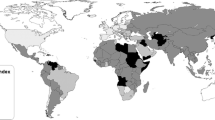Abstract
This paper contributes to the literature by examining whether conclusions from empirical models of corruption determinants are robust with respect to three alternative measures of corrupt activity for the US states. Are the determinants of US corruption sensitive to the choice of the measure of corruption? Overall, the answer to this question is that the choice of the measure of corruption matters in explaining corruption. However, some findings are robust across measures. For instance, greater educational attainment lowers corruption, while greater judicial employment adds to corruption. Southern states were found to be more corrupt, ceteris paribus. We also provide evidence that it is important to control for enforcement efforts in empirical modeling using convictions as a measure of corruption. Significant differences, however, across corruption measures occur in a number of other instances. Specifically, the effects of urbanization, economic prosperity, population size, media, government spending, and enforcement are sensitive to the measure of corruption. Further, the influences of the nation’s foreign neighbors and of the location of the state relative to the nation’s capital remain unclear.
Similar content being viewed by others
References
Aidt TS (2003) Economic analysis of corruption: a survey. Econ J 113: F632–F652
Alt JE, Lassen DD (2003) The political economy of institutions and corruption in American States. J Theor Politics 15: 341–365
Alt JE, Lassen DD (2008) Political and judicial checks on corruption: evidence from American State Governments. Econ Politics 20: 33–61
Banerjee AV (1997) A theory of misgovernance. Q J Econ 112: 1289–1332
Becker GS (1968) Crime and punishment: an economic approach. J Political Econ 76: 169–217
Becker GS, Stigler GJ (1974) Law enforcement, malfeasance and the compensation of enforcers. J Legal Stud 3: 1–19
Benson BL (1988) Corruption in law enforcement: one consequence of “The Tragedy of the Commons” arising with public allocation processes. Int Rev Law Econ 8: 73–84
Billger SM, Goel RK (2009) Do existing corruption levels matter in controlling corruption? Cross-country quantile regression estimates. J Dev Econ 90: 299–305
Boylan RT, Long CX (2003) Measuring public corruption in the American States: a survey of state house reporters. State Politics Policy 3: 420–438
Corporate Crime Reporter (2004) Public Corruption in the United States, January 16, Available at http://www.corporatecrimereporter.com/corruptreport.pdf
Donchev D, Ujhelyi G (2007) Do corruption indices measure corruption? Working paper. University of Houston, Houston
Fisman R, Gatti R (2002a) Decentralization and corruption: evidence across countries. J Public Econ 83: 325–345
Fisman R, Gatti R (2002b) Decentralization and corruption: evidence from US federal transfer programs. Public Choice 113: 25–35
Glaeser EL, Saks RE (2006) Corruption in America. J Public Econ 90: 1053–1072
Goel RK, Nelson MA (1998) Corruption and government size: a disaggregated analysis. Public Choice 97: 107–120
Goel RK, Nelson MA (2007) Are corrupt acts contagious? Evidence from the United States. J Policy Model 29: 839–850
Goel RK, Rich DP (1989) On the economic incentives for taking bribes. Public Choice 61: 269–275
Gundlach E, Paldam M (2009) The transition of corruption: from poverty to honesty. Econ Lett 103: 146–148
Jain AK (2001) Corruption: a review. J Econ Surv 15: 71–121
Klitgaard R (1988) Controlling corruption. University of California Press, Berkeley
Lambsdorff JG (2006) Causes and consequences of corruption: what do we know from a cross-section of countries?. In: Rose-Ackerman S (eds) International handbook on the economics of corruption. Edward Elgar, Cheltenham, pp 3–51
Lambsdorff JG, Teksoz SU (2004) Corrupt relational contracting. In: Lambsdorff JG, Schramm M, Taube M (eds) The new institutional economics of corruption. Rutledge, New York, pp 138–151
La Porta R, Lopez-de-Silanes F, Shleifer A, Vishny R (1999) The quality of government. J Law Econ Organ 15: 222–279
La Porta R, Lopez-de-Silanes F, Pop-Eleches C, Shleifer A (2004) Judicial checks and balances. J Political Econ 112: 445–470
Meier KJ, Holbrook TM (1992) ”I Seen my Opportunities and I Took ‘Em:” political corruption in the American States. J Politics 54: 135–155
Mookherjee D, Png I (1995) Corruptible law enforcers: how should they be compensated?. Econ J 105: 145–159
Olken BA (2009) Corruption perceptions vs corruption reality. J Public Econ 93: 950–964
Olson M (2000) Power and prosperity. Basic Books, New York
Paldam M (2001) Corruption and religion: adding to the economic model. Kyklos 54: 383–414
Pellegrini L, Gerlagh R (2008) Causes of corruption: a survey of cross-country analyses and extended results. Econ Gov 9: 245–263
Priks M (2010) Judiciaries in corrupt societies. Econ Gov. (in press)
Rose-Ackerman S (1999) Corruption and government. Cambridge University Press, Cambridge
Sampford C, Shacklock A, Connors C, Galtung F (2006) Measuring corruption. Ashgate, Aldershot
Serra D (2006) Empirical determinants of corruption: a sensitivity analysis. Public Choice 126: 225–256
Shleifer A, Vishny RW (1993) Corruption. Q J Econ 108: 599–617
Svensson J (2005) Eight questions about corruption. J Econ Perspect 19: 19–42
Treisman D (2007) What have we learned about the causes of corruption from ten years of cross-national empirical research?. Annu Rev Political Sci 10: 211–244
Treisman D (2000) The causes of corruption: a cross-national study. J Pub Econ 76: 399–457
US Department of Justice (1994) Office of Justice Programs, Bureau of Justice Statistics Bulletin, Federal Law Enforcement Officers, 1993, December, http://www.ojp.usdoj.gov/bjs/pub/pdf/fedlaw.pdf
Williams A, Siddique A (2008) The use (and Abuse) of governance indicators in economics: a review. Econ Gov 9: 131–175
Author information
Authors and Affiliations
Corresponding author
Additional information
Helpful comments by Dr. Amihai Glazer and a referee are appreciated.
Rights and permissions
About this article
Cite this article
Goel, R.K., Nelson, M.A. Measures of corruption and determinants of US corruption. Econ Gov 12, 155–176 (2011). https://doi.org/10.1007/s10101-010-0091-x
Received:
Accepted:
Published:
Issue Date:
DOI: https://doi.org/10.1007/s10101-010-0091-x




